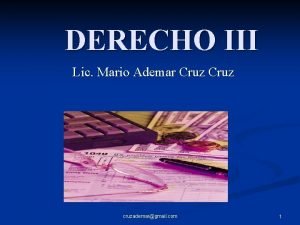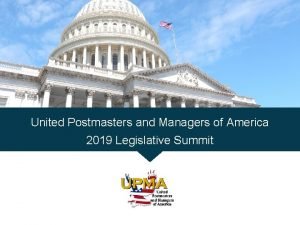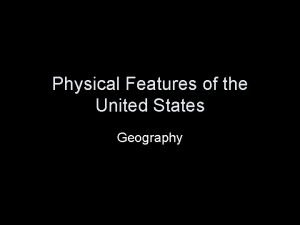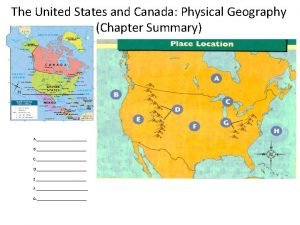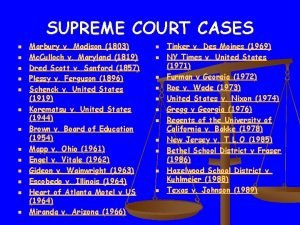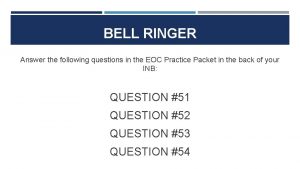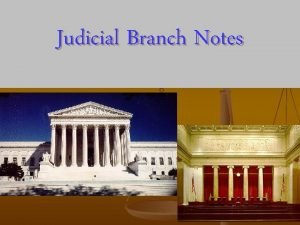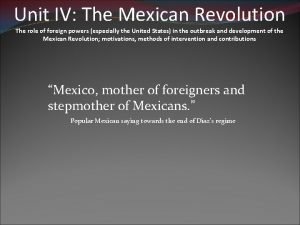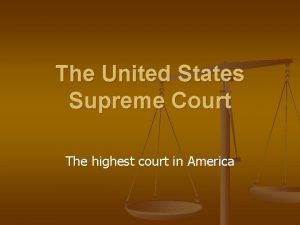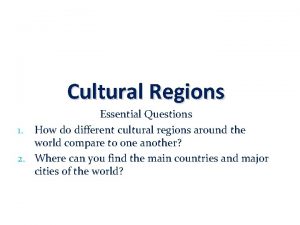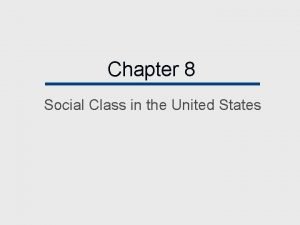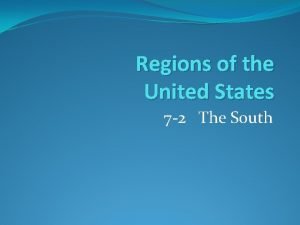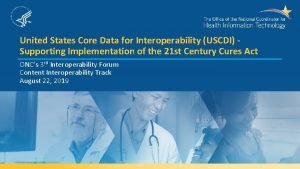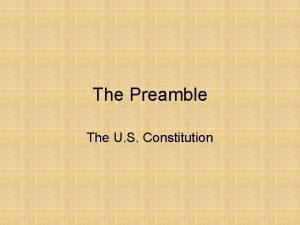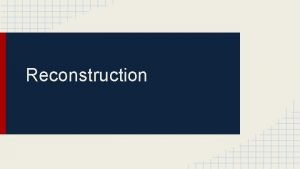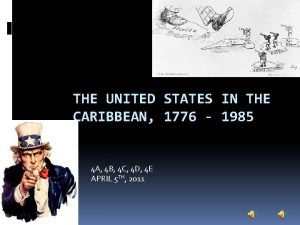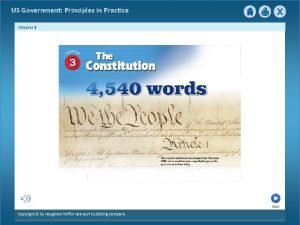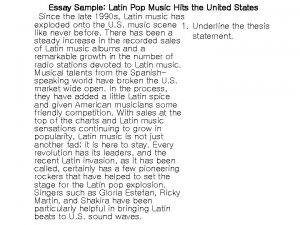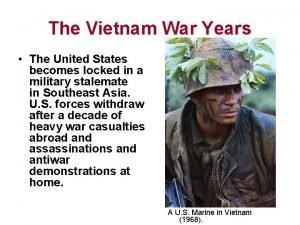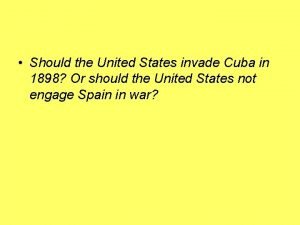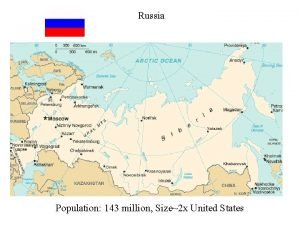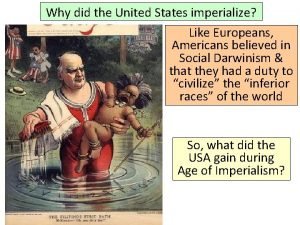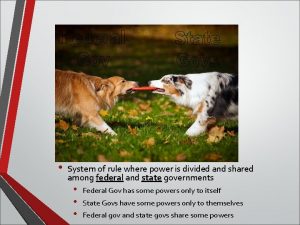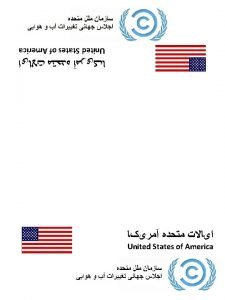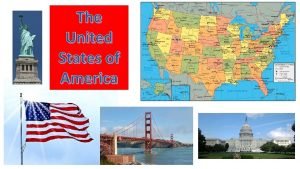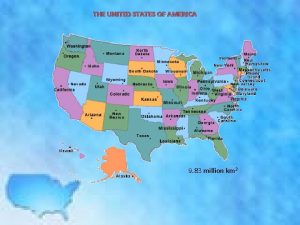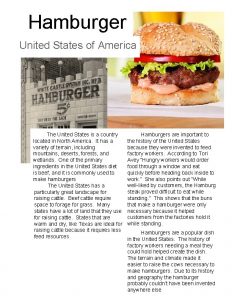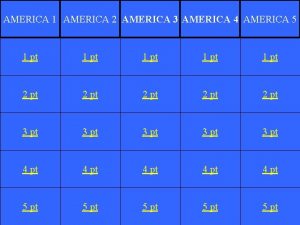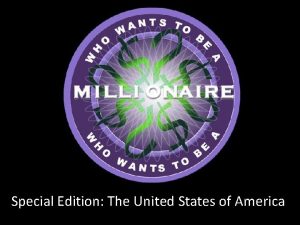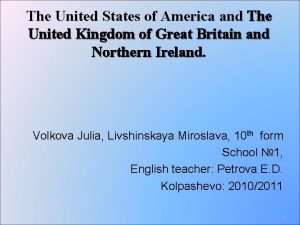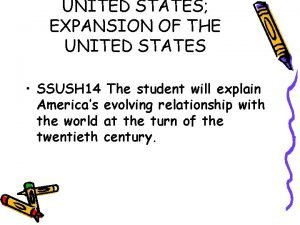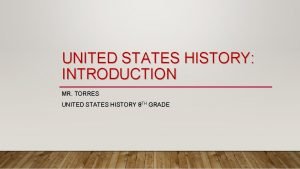Senorino R Cruz v United States of America






































- Slides: 38

Senorino R. Cruz v. United States of America Braceros Compensation and the Legacy of the United States Guest Worker Program By Ki. Ki Mosley and Mario Carlasare

• What is a Bracero as pertains to the Cruz litigation? – January 1, 1942 – December 31, 1946 • Who are Braceros in terms of a wider examination of the issue of legal and illegal day labor? • History of the Bracero pre-WWII – The Official Bracero Agreement Bracero(ra): a day laborer

�The 2 in 1 Bracero Contract ◦ K(1) = Bracero and United States Government �Work for the contracted harvest season and then repatriate to Mexico ◦ K(2) = United States Government and the U. S. Farmer �Assuming that the Bracero works for the season and then returns to Mexico Agency: • Transportation • Living expenses • Wages (same condition in the same geographic region) • Medical attention • Election of a peer that deals with issues with the Employer (U. S. ) • Unemployment insurance • Money from savings fund – 10% of wages earned

• Who got paid? – Requirements for payment in the Cruz class settlement • U. S. resident and a Bracero between January 1, 1942 – December 31, 1946 • Mexican passport, voting card, or military service card • Individual work contract, issued by a U. S. employer, showing participation in the Bracero program between 1942 and 1946 • Original proof of wages paid by the U. S. employer, showing participation during the required time period • Social security records showing payments from work in the program during the required time period • Original Consular Identification Card $$$

• The Bracero Litigation Players – Individual Braceros – Non-governmental organizations – Private law firms – U. S. Government – Mexican Government – Wells Fargo Bank • Orange County Register Community

• 1942 – 1964: 4. 6 million Mexicans legally admitted to the United States: 12% were Braceros under this program • 1952 – Texas Proviso • 1954 – Operation Wetback • 1960 – Mexican Community organizing/CBS Airs “Harvest of Shame” – Edward R. Murrow • 1963 – Kennedy Administration – years of transition – Mechanization • 1968 – Immigration and Nationality Act Unionization (1965 – 1980) Immigration Reform

Interpreting the Issues in Cruz and Beyond

The Effects of World War II • U. S. Production in 6 years of war: 87, 000 tanks, 296, 000 fighter planes, 2, 434, 000 trucks, 315, 000 pieces of artillery and mortar shells 53, 000 tons of maritime pieces (ships, boats, submarines) 1943 and 1944 – A ship a day, and an airplane every 5 minutes • Mexicans’ desire to contribute to the war effort by providing manual labor, escape the poor circumstances of the Mexican working class, and increase their overall wages.

General Provisions of the Bracero Agreement • No Military Service • Will not be discriminated against • Guaranteed transportation, living expenses, repatriation costs, under Article 29 of Mexican Federal Labor Law • Full Salary and coverage for expenses of a ‘migratory nature. ” • Mexican Health Authorities oversee health of the worker • “shall be the same as those paid for similar work to other agricultural laborers under the same conditions within the same area, in the respective regions of destination. Piece rates shall be so set as to enable the worker of average ability to earn the prevailing wage. In any case wages for piece work or hourly work will not be less than 30 cents per hour. ”

Savings Fund Provisions a. The respective agencies of the Government of the United States shall be responsible for the safekeeping of the sums contributed by the Mexican workers toward the formation of their Rural Savings Fund, until such sums are transferred to the Wells Fargo Bank and Union Trust Company of San Francisco for the account of the Bank of Mexico, S. A. , which will transfer such amounts to the Mexican Agricultural Credit Bank. This last shall assume responsibility for the deposit, for the safekeeping and for the application, or in the absence of these, for the return of such amounts. b. The Mexican Government through the Banco de Crédito Agrícola will take care of the security of the savings of the workers to be used for payment of the agricultural implements, which may be made available to the Banco de Crédito Agrícola in accordance with exportation permits for shipment to Mexico with the understanding that the Farm Security Administration will recommend priority treatment for such implements.

Cruz 1 – Procedural Background • Filed in the U. S. District Court of Northern California on March 2, 2001, and named Mexico, Banco de Mexico, Banrural, the United States, and Wells Fargo as Defendants. • Consolidated (Under Fed. R. Civ. P. 42(a)) with three cases from the District of Columbia: De La Torre v. U. S. , Chavez v. U. S. , Barba v. U. S. • Following an amended complaint in July 2001, all defendants moved to dismiss. The court granted the defendants’ motion to dismiss, focusing on three determinative issues: 1) Whether the Mexican Defendants were immune under FSIA, 2) Whether the Plaintiffs had stated a cause of action against Wells Fargo, 3) Whether plaintiffs claims against the U. S. were barred by the statute of limitations. Justice Breyer

The Foreign Sovereign Immunities Act (FSIA), 28 U. S. C. §§ 1330, 1602 -1611 • Became law in 1976 and formalized a more restrictive State Department approach to granting foreign sovereignty which had been in place since the publication of the Tate Letter in 1952. • The Tate Letter: On May 19, 1952, Jack B. Tate, Legal Adviser to the State Department wrote a letter to the Attorney General, “According to the newer or restrictive theory of sovereign immunity, the immunity of the sovereign is recognized with regard to sovereign or public acts (jure imperii) of a state, but not with respect to private acts (jure gestionis). ” Should FSIA be applied retroactively to the pre-1952 conduct of the Cruz defendants? • Landgraf v. USI Film Products 511 U. S. 244 (1994) • Republic of Austria v. Altmann, 541 U. S. 677 (2004)

Landgraf v. USI Film Products • Title VII case that was pending appeal to the Court of Appeals when President Clinton signed the Civil Rights Act of 1991. • The Supreme Court granted certiorari to determine whether provisions of the act should apply to cases pending when it became law. • “Petitioner emphasizes that § 402(a) begins: "Except as otherwise specifically provided… but we find it most unlikely that Congress intended the introductory clause to carry the critically important meaning petitioner assigns it. Had Congress wished § 402(a) to have such a determinate meaning, it surely would have used language comparable to its reference to the predecessor Title VII damages provisions in the 1990 legislation: that the new provisions "shall apply to all proceedings pending on or commenced after the date of enactment of this Act. " S. 2104, 101 st Cong. , 1 st Sess. § 15(a)(4) (1990). • The historical presumption against retroactivity can only be overcome by an “express statutory command. ” • Was the legislative intent to attach new legal consequence to past acts?

FSIA and Legislative Intent • Breyer: FSIA was not an effort to “change law that was 24 years old, ” but rather a codification of the Tate Letter. Also, Congress… • Failed to specifically negate time as a factor • Included a 90 day grace period, perhaps to provide foreign states notice of the new restrictive limits on immunity under FSIA. • The court ruled that FSIA applied only to claims arising after 1952 • Many Braceros claimed they had worked under the program into the 60 s, but Breyer relied on the “undisputed terms of the Bracero program. ” - One of the named Plaintiffs, Liborio Santiago Perez, claimed he had worked under the Bracero program until 1962.

Claims Against Wells Fargo • The complaint alleged…. - Breach of Contract -Breach of Fiduciary Duty and Resulting Trust -Accounting and Unjust Enrichment -Conversion -Unfair Business Practice • The other three consolidated cases alleged a violation of the Anti-Peonage Act.

Breach of Contract Against Wells Fargo • Based on the agreements Wells Fargo had with the U. S. and Mexico • Failed to make deposits to Banco de Mexico, or provide documentation. Against the U. S. and Mexico • Based on the umbrella agreements between the U. S. and Mexico, and claimed Wells Fargo was acting as an agent of the U. S. and Mexican Government and therefore liable. The court’s holding: • Bank Depositor Relationship is a unique kind of contract -No case history in California for allowing third party to raise claims for breach of contract between a bank and a depositor

Fiduciary Duty and Resulting Trust • Plaintiff’s claimed Wells Fargo had a Fiduciary Duty to the Braceros – to execute the successful transfer of the withheld funds to Banrural. • The court again held that banks are generally not considered fiduciaries for their depositors. • The braceros had no relationship, contractual or otherwise, with Wells Fargo, and the complaint failed to allege sufficient fact. Resulting Trust • Comes into effect when the transferee (Wells Fargo) ends up taking some kind of beneficial interest • Plaintiffs did not allege that any of the defendants expected Wells Fargo to hold the funds in trust – Breyer cited Plaintiff’s own complaint “as alleged…merely a conduit to facilitate the transfer of the funds…”

Accounting and Unjust Enrichment • The Plaintiffs relied on The Restatement of Restitution: A person receiving property for another from a third person has a duty to account to that person • The was no evidence that Wells Fargo, at any time, claimed to represent the braceros, and therefore should not be required to make an accounting. • Wells Fargo also did not receive a wrongful benefit from the Plaintiff • The court continued to stress the idea that Wells Fargo was merely an “intermediary to a transaction. ”

Conversion • A plaintiff can raise a claim for conversion only for property owned at the time of the conversion. • The defendants argued that since the withholdings were merely incentives for the braceros to return to Mexico, they were never owned by the braceros • The plaintiffs argued they had an equitable ownership interest • Breyer: The U. S. government owned the funds deposited to Wells Fargo, and the plaintiffs did not cite any case to suggest a third party can have an equitable interest in a bank deposit. • Since title for a deposit passes immediately to the bank upon deposit, a depositor has no conversion claim against a bank under California law • Exception: Special deposits – the depositor requests that the bank keep the funds apart and serve as trustee while he depositor retains title. • The plaintiff’s complaint did not plead the existence of a special deposit

Unfair Business Practice and The Anti-Peonage Act • California’s Unfair Business Practice Law § 17203, affords restitution or injunctive relief to “restore to any person in interest any money or property…which may have been acquired by means of such unfair competition. ” • The plaintiffs are not “persons in interest” – same argument as before – no liability to a third party who has no direct interest. Anti-Peonage Act • Peonage: a condition of compulsory service based on indebtedness of a servant to a master – MUST SHOW – 1) indebtedness, and 2) compulsion. • Plaintiffs’ claim states that Wells Fargo had an affirmative duty to protect them from the exploitation they suffered at the hands of their employers. • Breyer: The plaintiffs have cited absolutely no authority to support the position that a party can be held liable for failing to protect individuals from a state of peonage imposed by others.

Claims Against the U. S. Breach of Contract (each individual braceros’ express contract) • The Little Tucker Act, enacted in 1887, waived U. S. sovereign immunity status and allowed a plaintiff to file suit for breach of express or implied contracts pursuant to 28 U. S. C. § 1346(a)(2). • Six-year Statute of Limitations problem? -Under Federal law, SOL begins to run when the plaintiff knows, or should know, of the injury, or the cause, for which the claim is based. • The plaintiffs claimed ‘equitable tolling’ since many of the braceros were illiterate and unable to understand the savings plan they were subject to. • The court found that the braceros may have had limited legal understanding of the savings plan, but were NOT ignorant of the fact that their wages were being garnished, only of “the amount of money deducted…. ” (Facts plead in the Plaintiffs complaint, and consolidated complaints)

The Revelations and Ramifications of Cruz 2 • 8/23/02 - The District Court dismisses all claims in Cruz 1 • 12/12/02 – The United States Court of Appeals for the Ninth Circuit decides – Altmann v. Republic of Austria, 317 F. 3 d 954 (9 th Cir. 2002) ( Altmann I ) • As a result, Cruz plaintiffs file a motion for reconsideration • 6/24/03 – Motion for reconsideration was denied – the court ruled that the 9 th Circuit’s holding regarding FSIA’s retroactivity was limited to Altman. • 6/7/04 - The Supreme Court, having granted certiorari, affirmed Altman on the grounds that FSIA is retroactive generally. • 6/16/05 – Justice Breyer writes the opinion for Cruz 2 (Altmann gave new life to plaintiff’s claims that were equitable in nature; those based off the third party beneficiary theories remained barred)

Altmann v. Republic of Austria • The heir of the original owner of priceless paintings sued the Republic of Austria and a state owned art gallery for the return of paintings stolen by the Nazis in violation of international law. • The Supreme Court (Justice Stevens) held that FSIA applies to conduct that occurred prior to its enactment AND before the U. S. adopted a restrictive theory of sovereign immunity. • Restrictive Theory: Immunity for a foreign sovereign’s public acts, but not for its private acts. Created disarray in the State Department regarding immunity decisions. • “Transferred primary responsibility for immunity decisions to the Judicial Branch. ” • Court’s view of FSIA objectives: 1) clarifying the rules judges should apply in resolving sovereign immunity claims and 2) eliminating political participation in the resolution of such claims.

Altmann v. Republic of Austria • “To begin with, the preamble of the FSIA expresses Congress' understanding that the Act would apply to all postenactment claims of sovereign immunity. That section provides: “ Claims of foreign states to immunity should henceforth be decided by courts of the United States and of the States in conformity with the principles set forth in this chapter. ” 28 U. S. C. § 1602 (emphasis added). Though perhaps not sufficient to satisfy Landgraf's “express command” requirement, 511 U. S. , at 280, 114 S. Ct. 1483, this language is unambiguous: Immunity “claims”-not actions protected by immunity, but assertions of immunity to suits arising from those actions-are the relevant conduct regulated by the Act; those claims are “henceforth” to be decided by the courts. As the District Court observed, this language suggests Congress intended courts to resolve all such claims “in conformity with the principles set forth” in the Act, regardless of when the underlying conduct occurred. ” • “The office of the word “henceforth” is to make the statute effective with respect to claims to immunity thereafter asserted. Notably, any such claim asserted immediately after the statute became effective would necessarily have related to conduct that took place at an earlier date. ”

FSIA and The Commercial Exception • FSIA has exceptions to immunity foreign sovereigns, one of which is activity performed in the “regular course of commercial conduct or a particular commercial transaction or act. ” • Cruz plaintiffs argued that Mexico was not immune because its conduct qualified as a ‘commercial activity’ not protected by FSIA. • The standard for the court was “the type of actions by which a private party engages in. . . , ” and found that the Mexican defendants had acted more like private players than sovereign regulators. • The court also found sufficient nexus between the cause of action and the alleged activities of the Mexican defendants, and numerous substantial contacts between the U. S. and Mexico. • The court held that the Mexican defendants were not immune under FSIA because the conduct alleged was commercial in nature.

The Defendants Strike Back Personal Jurisdiction • The defendants argued that if the court asserted personal jurisdiction, it would be unconstitutional – a violation of the due process clause. - plaintiffs successfully argued that the defendant banks were not “persons within the meaning of the due process clause. ” -Principles of international law, a separate system under the Federal Government, govern foreign states’ jurisdictional rights, not the constitution Act of State Doctrine • The doctrine operates to avoid political and foreign policy conflicts caused by the official acts of a foreign state. It is applied when an official act, performed in a state’s own territory, and a cause of action requires a U. S. court to declare the act invalid. Courts consider three factors: 1) Whether the act was done in the public interest 2) Whether it is supported internationally 3) Whether its condemnation would interfere with the U. S. foreign policy

The Act of State Doctrine and International Comity • The defendants urged the court to adopt the doctrine of international comity. • for the sake of convenience and international duty • Mexico had created a special commission to investigate the complaints of the braceros: Gobernación Claims Program - The court refused to adopt international comity or the Act of State Doctrine, because it found that as of 2003, the commission had produced nothing more than recommendations and was a preliminary effort at best, not the kind of “legislative, executive, or judicial act” normally subject to comity. • Since the defendants failed to produce a “statute, decree, order, or resolution, ” the court did not invoke the application of the Act of State Doctrine. TO BE CONTINUED…

Statute of Limitations and Choice of Law • The ultimate question became whether to apply the statute of limitations of Mexico or California • Under the Restatement of Restitution § 142, the forum state would usually use its own statute of limitation unless it did not have a substantial interest in the case, or the statute of another state, with more substantial interest, would bar the claim. • Class counsel maintained an ongoing effort to vehemently lobby the state and federal legislature in both Mexico and the U. S. to pass a resolution of braceros’ claims. President Bush’s agenda for immigration reform, a priority for his administration, was interrupted by September 11. • 9/29/02 – Class counsel (incl. our guest speaker Josh Karsh) was successful in getting the California General Assembly to pass a resolution, CCP § 354. 7, that effectively erased and statute of limitation problem in California. The resolution set 12/31/05 as the deadline for filing a claim.

Statute of Limitations and Choice of Law • The Mexican statute of limitations was 10 years, and there is no concept of equitable tolling. • Since many of the braceros were now California citizens, and California had substantial contacts, the court ruled in favor of California’s limitation statute. • After further analysis, the court also held it would be most appropriate, for the sake of providing a uniform result and benefiting MexicoU. S. relations, to apply Mexican law. • CCP § 354. 7 was vital to keeping the plaintiffs’ legal claims alive. It was an important basis for the court repeatedly denying defendant’s motions to dismiss. By 2005, it had no doubt significantly contributed to the Mexican Congress appropriating $27 million for bracero compensation through the Gobernación Claims Program. The compensation, however, was only for Mexican braceros and not those that were now U. S. residents.

CCP § 354. 7 and The Act of State Doctrine • Increased pressure on Gobernación Claims Program to provide better compensation • Weakened the plaintiffs’ argument against applying the Act of State Doctrine • The Defendants went on to appeal the case to the Ninth Circuit • 10/8/08 – The Ninth Circuit dismissed the pending appeal in response to the parties stipulations • 10/10/08 – the District Court granted the parties’ motion to preliminarily approve of a class action settlement. WHY DID THE DEFENDANT’S SETTLE?

A Preview of Our Guest, Josh Karsh • Attorney for Hughes Socol Piers Resnick & Dym, Ltd. who got involved with Cruz in 2003 while in Mexico administering the settlement of another case. WHY DID THE DEFENDANT’S SETTLE? -How did settlement talks begin? -Were the defendants going to prevail because of the Mexican Statute of Limitations defense? -Why did the Act of State Doctrine continue to pose a serious risk to litigation even after the court in Cruz 2 ruled the Mexican Gobernación Claims Program to be too ‘preliminary’ in nature? -Any idea why Mexico decided to settle and extend compensation coverage to braceros living in the United States as well?

The Bracero Experience • Example journey of a Bracero: – Travel to Chihuahua City – Interviewed twice • Short Interview – Cursory Information • Long Interview - Interrogation • Contract Signed • Transported to the border (2) – Juarez El Paso – El Paso Fabens – Fabens (El Paso) • De-loused and fed • Farmers Selection


Alien Laborer’s Permit

The Work • Treatment – – – Crop Specific Permits Hours Communication Salary Tools • The Short Handle Hoe – – Current Law Current Use Other options Reason for use

• Modern Immigration Reform – Dissolution of the INS – Development of United States Customs and Immigration Services (USCIS) and a division of the Department of Homeland Security • Visas – Immigrations and Customs Enforcement (ICE) • Removal – The fate of the Guest Worker Visa Program • Cost • Backlog Immigration Reform

• “What has been accomplished is impressive. It is a rare case in which U. S. lawyers manage to obtain the agreement of a foreign sovereign to submit to the jurisdiction of U. S. courts in order to pay reparations to residents of the United States and to give them priority in payment over residents of the sovereign's own country. It is likewise rare for the government of Mexico to accord recognition to citizen protests in general or the braceros in particular. This settlement has achieved all of that and against overwhelming odds, given the age of the claims and the procedural and substantive obstacles to proving them on a classwide basis in United States courts. ” - Motion and Memorandum in Support of Final Approval of Class Settlement, WL 728225 (N. D. Cal. 2009)

Topics for Mr. Karsh • A excellent example of how public interest lawyers can effectuate true change by continuing to pressure the political system. • The limits of judicial processes for achieving true reform: The Act of State Doctrine, Foreign Sovereign Immunity • Financing class actions and other litigation • The role(s) of community organizing (its possible backlash), and media coverage. • Agency Issues; absent class members? • Legislative lobbying • The efficacy of judicial remedies, and the deterrent value of litigation • Actual Stories • Interaction between private and government counsel (EEOC & DOJ)
 Expansion of the united states of america 1607 to 1853 map
Expansion of the united states of america 1607 to 1853 map Physical features of the southeast region
Physical features of the southeast region Mario ademar cruz cruz
Mario ademar cruz cruz United postmasters and managers of america
United postmasters and managers of america Was the united states on the axis powers or allied powers?
Was the united states on the axis powers or allied powers? Geophenom
Geophenom Major physical features of united states
Major physical features of united states Define landform
Define landform Ap grading review
Ap grading review Heart of atlanta motel v. united states
Heart of atlanta motel v. united states Bell ringer response sheet
Bell ringer response sheet Sentinel ffa symbol
Sentinel ffa symbol Judicial branch
Judicial branch What the united states has fought for
What the united states has fought for What is the highest court in the united states? *
What is the highest court in the united states? * Kentucky primary care association
Kentucky primary care association Perceptual regions of the united states
Perceptual regions of the united states Marshall case
Marshall case What are the social classes in the united states
What are the social classes in the united states States west of the mississippi river
States west of the mississippi river 7 regions of the united states
7 regions of the united states True or false
True or false United states latitude map
United states latitude map Uninhabited us territories
Uninhabited us territories Us core data for interoperability
Us core data for interoperability Whats the preamble
Whats the preamble United states v. cruikshank apush
United states v. cruikshank apush President help wanted ad
President help wanted ad The united states in the caribbean 1776-1985
The united states in the caribbean 1776-1985 United states government: principles in practice
United states government: principles in practice Latin pop music history
Latin pop music history United states map with longitude and latitude lines
United states map with longitude and latitude lines Unit 2 the united states and canada
Unit 2 the united states and canada Vietnamese government
Vietnamese government Aiesec gis
Aiesec gis We have pacified some thousands of the islanders
We have pacified some thousands of the islanders United states
United states Why did the united states imperialize
Why did the united states imperialize Us vs lopez summary
Us vs lopez summary


